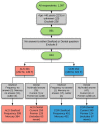A Comparison of Mercury Exposure from Seafood Consumption and Dental Amalgam Fillings in People with and without Amyotrophic Lateral Sclerosis (ALS): An International Online Case-Control Study
- PMID: 30558238
- PMCID: PMC6313312
- DOI: 10.3390/ijerph15122874
A Comparison of Mercury Exposure from Seafood Consumption and Dental Amalgam Fillings in People with and without Amyotrophic Lateral Sclerosis (ALS): An International Online Case-Control Study
Abstract
Exposures to toxic metals such as mercury have been suggested to be risk factors for amyotrophic lateral sclerosis (ALS). Human intake of mercury commonly occurs via consumption of seafood or from mercury-containing amalgam dental restorations ('mercury fillings'). We therefore compared mercury exposures from these sources in 401 ALS and 452 non-ALS respondents, using an internationally-available online questionnaire that asked respondents how often they ate seafood and what their favourite types of seafoods were. Respondents were also asked to record numbers of current or former mercury fillings. ALS and non-ALS respondents did not differ in their frequency of seafood consumption or in monthly mercury intake from favourite seafoods. Both groups had similar numbers of current, as well as former, mercury fillings. In conclusion, this study found no evidence that mercury exposure from eating seafood, or from mercury dental fillings, was associated with the risk of developing ALS. Therefore, if mercury does play a role in the pathogenesis of ALS, other sources of exposure to mercury in the environment or workplace need to be considered. Alternatively, a susceptibility to mercury toxicity in ALS, such as genetic or epigenetic variations, multiple toxic metal interactions, or selenium deficiency, may be present.
Keywords: ALS; amyotrophic lateral sclerosis; case-control study; dental amalgam filling; fish consumption; international study; mercury; motor neuron disease; online questionnaire; seafood.
Conflict of interest statement
The authors declare no conflict of interest.
Figures





Similar articles
-
Mercury exposure assessment in Iranian women's hair of a port town with respect to fish consumption and amalgam fillings.Sci Total Environ. 2010 Mar 1;408(7):1538-43. doi: 10.1016/j.scitotenv.2010.01.008. Epub 2010 Jan 25. Sci Total Environ. 2010. PMID: 20100624
-
Amyotrophic Lateral Sclerosis Risk, Family Income, and Fish Consumption Estimates of Mercury and Omega-3 PUFAs in the United States.Int J Environ Res Public Health. 2021 Apr 24;18(9):4528. doi: 10.3390/ijerph18094528. Int J Environ Res Public Health. 2021. PMID: 33923256 Free PMC article.
-
The mercury concentration in breast milk resulting from amalgam fillings and dietary habits.Environ Res. 1998 May;77(2):124-9. doi: 10.1006/enrs.1997.3813. Environ Res. 1998. PMID: 9600805
-
Increased mercury release from dental amalgam restorations after exposure to electromagnetic fields as a potential hazard for hypersensitive people and pregnant women.Rev Environ Health. 2015;30(4):287-92. doi: 10.1515/reveh-2015-0017. Rev Environ Health. 2015. PMID: 26544100 Review.
-
Dental amalgam and mercury in dentistry.Aust Dent J. 2000 Dec;45(4):224-34. doi: 10.1111/j.1834-7819.2000.tb00256.x. Aust Dent J. 2000. PMID: 11225523 Review.
Cited by
-
The Prevalence of Inorganic Mercury in Human Kidneys Suggests a Role for Toxic Metals in Essential Hypertension.Toxics. 2021 Mar 21;9(3):67. doi: 10.3390/toxics9030067. Toxics. 2021. PMID: 33801008 Free PMC article.
-
Potentially toxic elements in the brains of people with multiple sclerosis.Sci Rep. 2023 Jan 12;13(1):655. doi: 10.1038/s41598-022-27169-9. Sci Rep. 2023. PMID: 36635465 Free PMC article.
-
Effect of alpha-mangostin in the prevention of behavioural and neurochemical defects in methylmercury-induced neurotoxicity in experimental rats.Toxicol Rep. 2022 Apr 22;9:977-998. doi: 10.1016/j.toxrep.2022.04.023. eCollection 2022. Toxicol Rep. 2022. PMID: 35783250 Free PMC article.
-
Neuron Protection by EDTA May Explain the Successful Outcomes of Toxic Metal Chelation Therapy in Neurodegenerative Diseases.Biomedicines. 2022 Oct 4;10(10):2476. doi: 10.3390/biomedicines10102476. Biomedicines. 2022. PMID: 36289738 Free PMC article. Review.
-
Oxidative Stress in Amyotrophic Lateral Sclerosis: Synergy of Genetic and Environmental Factors.Int J Mol Sci. 2022 Aug 19;23(16):9339. doi: 10.3390/ijms23169339. Int J Mol Sci. 2022. PMID: 36012603 Free PMC article. Review.
References
Publication types
MeSH terms
Substances
LinkOut - more resources
Full Text Sources
Medical
Research Materials
Miscellaneous

